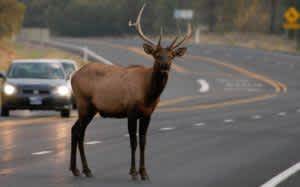Arizona GFD Partners with ADOT to Make Highways Safer
OutdoorHub 07.16.12

Many motorists have wondered what the new 8-foot fences are along Interstate 17 near Munds Park. These “exclusion fences” are designed to keep elk off the highway as part of a larger statewide effort to make highways safer for motorists and wildlife.
This transportation enhancement project is a cooperative effort between the Arizona Game and Fish Department and Arizona Department of Transportation.
Elk are a common sight along I-17. Research indicates that I-17 has the highest rate of elk-vehicle collisions in the state. An elk can weigh more than 800 pounds, and a collision with an animal that size can have serious consequences.
In an effort to minimize vehicle-wildlife collisions, Game and Fish captured elk and fitted them with radio transmitter collars in order to follow their daily movements. This information tells biologists where the elk prefer to cross the highway and how often.
Game and Fish worked with ADOT to design an elk exclusionary fencing project and to pursue funding opportunities. The exclusionary fencing must be at least 8 feet high to keep elk from jumping over it and entering the roadway. If the elk enter the fenced areas adjacent to the interstate, escape ramps (large mounds of dirt) will allow them to safely leave the area and avoid being trapped.
As research has been conducted over the years, biologists have learned that wildlife will only utilize certain overpass and underpass designs. ADOT uses this information to construct specific structures and install fencing to funnel animals over or under the highways, as was the case on I-17 between Woods Canyon (milepost 317) and Munds Canyon (milepost 322) bridges.
“As we identify portions of the highways in Arizona that are active with wildlife, we can work closely with ADOT and create wildlife-friendly roadways which in turn will decrease the number of vehicle collisions, especially those involving elk,” says Jeff Gagnon, research biologist for Game and Fish. “We (Game and Fish and ADOT) have already completed several projects across the state and will continue this partnership to make highways safer for motorists.”
One major success story in Arizona is the State Route 260 project east of Payson. Fencing was installed to keep elk off the road and force them to safer crossing locations. Results from this project showed an 85 percent reduction in vehicle-elk collisions. Elk and other wildlife are moving under bridges that are similar to those structures along I-17 near Munds Park.
Game and Fish and ADOT are also addressing wildlife and roadway issues in other parts of northern Arizona, including Interstate 40 between Williams and Flagstaff, State Route 64 between Williams and the Grand Canyon, and U.S. 89 between Doney Park and Gray Mountain north of Flagstaff.
This past winter, especially during January and February, multiple deer and elk collisions occurred along U.S. 89 between Townsend-Winona and Silver Saddle roads in Doney Park. Although signs are already in place along the roadway to warn motorists and portable message signs are occasionally used, motorists should be aware that this stretch of roadway runs through a wildlife travel corridor. This is a “road” used by deer and elk to move back and forth during their seasonal migration from the foothills of Mount Elden to Turkey Hills and other areas east of U.S. 89.
Game and Fish and ADOT remind motorists that when travelling on roadways in Arizona, be aware of wildlife and maintain safe speeds, especially when driving between sundown and sunrise.
The joint project was funded by the Federal Highway Administration through the Transportation Enhancement Program. States like Arizona are required to allocate 10 percent of their federal transportation funding for enhancement projects, which are limited to specific types of projects. Fences designed to reduce vehicle-wildlife collisions are among the eligible projects.
Information about the wildlife-friendly highway projects can be found on the Arizona Game and Fish website at www.azgfd.gov/wildlifeplanning and ADOT at www.azdot.gov/inside_adot/OES/AZ_Wildlife_Linkages.

